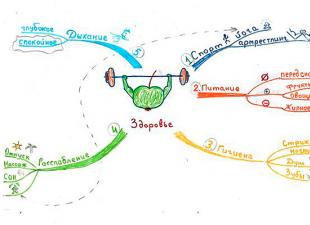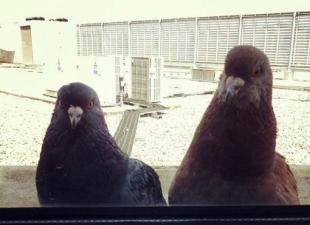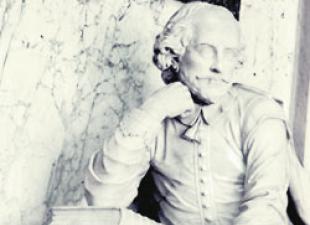Naturally, fertility cults enjoyed considerable influence among the lower strata of German society. There is a wealth of evidence that these life-giving forces inspired respect for more than one peasant. As one would expect, various symbols of fertility appear on stone drawings of the Bronze Age in Scandinavia, although, of course, we don’t know any details of this cult until the Roman period. In the 1st c. n e. Tacitus tells us that the seven tribes that lived in the Danish peninsula and in Schleswig-Holstein revered a female deity named Nerth; Roman authors identified her with Mother Earth. She could influence the affairs of people, and sometimes - perhaps annually - the goddess visited her admirers, arriving in a chariot and bringing fertility to people and fields. However, people could never see her (or her image), and no one except the priest could look inside her sacred wagon or even touch it. One he could feel the presence of a deity. These and some other mystical elements in the cult of Nerta resemble Middle Eastern and Greco-Roman fertility cults. During Nerta’s visits to the human world, wars ceased; even all the iron objects were removed away. In the interval between the journeys Nerta and her cart went to the sacred grove on the island, and after each trip there was a ritual ablution in the lake of an image or symbol of the goddess, the cart itself and the overhang above it. The slaves who performed this work, after its completion, were drowned in the lake.
Lucina. In ancient Roman religion and myth, Lucina was the goddess of childbirth who protected the lives of women in labor. Lucina was also an epithet for Juno. This name usually meant “she who brings children to the world,” but can actually be obtained from a bow after a sacred lotus grove on Esquiline Hill, associated with the goddess, and then in the place of her temple. Lucina was chief among many deities who influenced or were guided by every aspect of child development and childbirth, such as Vagitanus, who opened the mouth of the newborn to cry, and Fabulinus, who allowed the child’s first formulated speech.
Two richly decorated ceremonial carts were found in the swamp in Dejbjerg (Jutland). Archaeologists have often associated them with cult detours like what was described by Tacitus. We can not neglect the fact that the place of their discovery exactly coincides with the area about which Tacitus speaks of as the center of the cult of Nerta. These fine chariot works were made by Celtic artisans, most likely in Gaul, sometime before Christ. They were found in a peat bog disassembled. It can be assumed that the wagons ultimately sacrificed to the deity they served.
Kliona is the goddess of love and beauty. She is said to have three bright birds that eat apples from an otherworldly tree and whose sweet song heals the sick. She was depicted in art as a beautiful young woman carrying a cornucopia, scepter, torch or rhyton. It is said that sometimes she is the daughter of Zeus and Themis. It is traditionally called the singing of birds circling the head. The mill from Aquileia to Jadran is already across Kirkby Lonsdale to England. He is the guarantor of contracts, punishing their failure. During Christianity, his place was primarily holy, such as Blazij, Mikoláš, Jiří and Sava, sometimes identified with the devil or the devil.
Far from southeastern Denmark, we meet another deity who was traveling in a wagon. This occurred during the time of persecution of Christians among the Goths at the end of the 4th century. n e. The Gothic leader Atanarih ordered to put some kind of idol (the Greek writer, who leads the story, calls him simply a xoan) in a wagon and carry him around those suspected of being Christians, and these people should have offered the idol of the sacrifice. Although we are not told what kind of deity this Xoan depicted, the way the image was taken on a cart — in circles, very reminiscent of how Nerta cared about the fertility of the fields and cattle.
The Swedes called him Oden, Anglosas Vodan and Langobardi Godan. Much of the information about this, however, comes from Norse mythology, which was completely preserved in Elders and Young Eden. According to Norse mythology, Odin is the son of the Giant Bora and the greatest giant. He is the Father of Unity, the patron of poets, warriors and statesmen, the god of death, war and magic. He is also the god of ecstasy, ecstatic poetry and shamanic spells. You can change the shape, control the mind of enemies, and divine magic.
During the Great Migration and later another fertility deity, this time male, traveled through the fields during the harvest, bringing prosperity and peace with it. This god was Freyr, the son of Njord, whose very name reminds of Nert. Snorri says that Freyr and his wife Freyja belonged to a group of divine beings called “vans,” who were mostly in charge of the welfare and fertility of people and their world. Some aspects of the Freyr cult almost coincide with what we know about the Nerta cult. No weapons could be brought into his churches, and the blood shed on the Freyr Initiative land brought the wrath of the deity to the criminal. One of the sagas mentions an extremely fertile field, which, apparently, belonged to the nearby temple of Freyr, and some Norwegian names for places and fields to which Freyr's name belongs can also mark his venerations. Marriage and the birth of children were also under the auspices of this god.
Like all Asians, it is practical. Together with his two brothers, he is one of the creators of the people who gathered spirit and life together. He sacrificed to humanity to get the runes, and in his left eye he reached the “wisdom of the ages” when he drank from Mimi. He is described as an elderly tall man with one man. And human sacrifices were made to him in ancient times. Among his plants are ash, mistletoe, oak, miller, stylist and elm. Dionysus, Denis - the Greek god of wine Sylvan - the Roman god of forests.
The mythology of the Aztecs abounds in such deities.
Mythology and religion is full of gods and goddesses of desire, love and sex. The deity of love is always associated with sexuality. These deities are common to mythology and can be found in many polytheistic religions. Nanaya - Nanai is a powerful deity associated with sensuality and voluptuousness, a popular deity worshiped by Akkadian and Sumerian; Ishtar - the goddess associated with gender, fertility, war and love in Babylon; Ninth fertility immunity associated with female organs.
Celtic mythology and goddesses of love
Chinese mythology and gods of desire. Bes, the goddess of music, dance and sexual pleasure Hathor, the goddess of the sky, love, beauty and music Bastet, the goddess of cats, love, sexuality, protection, aroma, beauty and dance Ming goddess of sexuality, reproduction, love and sexual pleasure.Northern and German mythology
Freyja, goddess of love, beauty, magic, shamanism, sacrifice, war, death and sexuality Freyr, god Frigga fertility, goddess of marriage, family and divination Lofn duty, goddess of love forbidden servant goddess Asgard, Frigg Sjöfn goddess associated with love. Her first client, a prostitute should have made a sacrifice to him. . For your information, not only legends that seem incredible a generation later. - Lucius Apuleius.Sources from the late pagan period clearly show that Freyr was a revered fertility deity in Northern Europe at that time, but we cannot clearly imagine how he occupied such a prominent position. In the Roman period and in the era of the Great Migration of Nations, both female and male fertility deities were revered. Some scholars even thought that Njord and Nerta were a married couple, and Njord (and later his son Freyr) began to play a leading role in this pair. However, experts have not yet arrived at a definite conclusion. Only one thing is certain: in the period of the Great Migration of Nations and later not a single female deity, even Freyja, could shake Freyr's position.
Egyptian religion historian Plutarch says that science is dark and mysterious. Each major city had its own "NTR" and myths, the gods were only in appearance, but different. Their names may be from Anu Ansari’s father in Akkadian myths. Sun-god, present in most cultures, means the leader of the function of God. Because the Sun is the center of the Solar System with planets in orbit around it, like a ruler of God among gods, like "orbital" around it. Although Egyptologists tried to translate the name of God in various ways, the true meaning is found in Sumerian, where among the many meanings of the word "rational" is also "leader."
The horse and the boar were closely associated with Freyr and Freya. In the sacred places of Freyr or near them in Norway and Iceland kept horses. Some of them became food for God; others may have had to show the dexterity and speed of running during the races on holidays dedicated to the deity. The boar was closely associated with fertility and chthonic cults in many cultures of ancient Europe, and in ancient Germany it was both a symbol of fertility and a banner that protected warriors (see p. 142).
The Egyptians called the "head" the god of their pantheon of the head, giving it also the position of the sun god to strengthen their power. Graduations are found in the names of many deities with leaders from different cultures. For example, Indra, the king of the gods in Hinduism. Its name is translated correctly as “Indian leader” or “head of the Indus Valley.” In Egypt, Amon-Ra is not a union of two competing deities, as interpreted by Egyptologists. As the word "Amon" means "hidden" god Amon-Ra was considered the Egyptian epithet "hidden driver".
Born in the ocean of Nun, Ra was presented as a falcon with a human head, his symbol is an obelisk. The Book of the Dead says that Ra cut his phallus, which dropped a drop of blood, which gave rise to two personifications of the intellect X and Saa. Two children born this way are actually two sons, Anu, Enlil and Enki. Another myth is that the children of the first Egyptian Ra were Shu and Tefnut. Again we meet the two sons of Anu: Enlil and Enki. It seems that the priests knew the truth, because in a procession from the Temple of Hathor in Dendera, her statue was taken inside the sanctuary to the roof, where he built a special chapel for the ceremony of the unifying goddess of the solar disk.
Another symbol that connects Freyr with both fertility and funeral rites was the ship. The symbol of the ship is also found in the drawings of the Bronze Age, and it, like the wagon of Nerta, was later used to carry the god of abundance around the country at certain times of the year. Processions with ships in different areas of Scandinavia survived the condemnation of medieval clerics and remained the basis of the rituals of blessing the fields until relatively recently.
In the heliopolitical religion, Geb or Keb was the god of Earth. The primary leader of Egypt, was originally presented as a bearded man, then portrayed as a ram, bull, crocodile or snake of a human head. In some myths, it is even called the "father of snakes." In Heliopolis, he was rewarded as the wife of Nut, the goddess of heaven. This is due to vegetation, but also to the underworld. As the god of the Earth, represented as a serpent, a crocodile or a ram associated with the underworld, Geb is a Sumerian Enki.
His sister and wife, Walnut, the goddess of Heaven, is the very same Ninhursag who is often called the "Queen of Heaven." Although the Mesopotamians tried to present Enki in a positive light, his evil side comes from the demon Pazuzu. The Egyptians tried the same thing with Osiris, but of them we have more detailed information about the true image of the first leader of our planet. According to Plutarch, the Egyptians said that Osiris was born on the right and will die on the left. This is why Osiris was often called the “first of the Ascended,” the west, symbolizing the left, and the east right.
For centuries, people believed in something. Finding no explanation for many things around them, our ancestors are used to believing that these phenomena are controlled by higher powers. Thus a huge number of gods appeared. On the territory of Ancient Russia, it was believed that each element, each case in which a person is engaged, is governed by its own god. So, the god of the summer sun, nature - it is Dazhdbog, the goddess of water - Dana, Dodola or Perunitsa - ruled thunderstorms and lightning, being simultaneously the wife of Perun, the god of fertility - Mokosh, etc.
In the Book of the Dead, Osiris is called "a gentleman over souls, like a horror." Although Osiris was often represented by green skin, Plutarch claims that god was black. In fact, the Book of the Dead even calls it "the great black." All these descriptions lead us to the idea of a devilish ruler of hell, different from the benefactor of mankind, represented by his followers. The testimony of the myth of the Axis is the concrete evidence of the last pharaoh of the djasty, Jedkar Izezi, who ruled between 414 and 375 BC.
Probably, Denven is another name for Apophis, the first evil god, later considered a demon, the personification of darkness, chaos and evil, an adversary of light and maat, an enemy of Ra, the husband of demons Taveret. Apophis is in the form of a giant snake, crocodile, lizard or dragon and is also called the Nile Snake or the Evil Lizard. In the Book of the Dead, he lives in a world outside, where he attacks the barracks of Ra every night, fighting with him and his companions, including Seth, the god of the storm. In fact, this daily struggle is nothing more than a remake of the struggle of the old days, when Apophis attacked Ra, just like Kumarbi on Anu on the Hittites.
Every craft, every season and natural strength, every animal and plant had its own god. This was the basis of the pagan gods sacrificed, they were coaxed, they were prayed, asking for protection, protection and assistance.
So, for a good harvest, for high fertility, the Slavs sang odes to his wife Veles - Mokos. Along with her, people worshiped Rozhanitsy - goddesses who patronized all living things, including female fertility. Mokosh - the god of fertility among the Slavs, or rather, the goddess, is found in ancient chronicles, but the information presented there is not always clear, and often quite contradictory. Mokosh was sometimes identified with the Mother of the damp earth. A tall, stately woman with a large head and incredibly long hands - this is the image of a goddess on ancient embroideries, Slavic towels and handicrafts.
Seth and other gods fought with their leader, succeeding in the victory over the Great Serpent and closing it in the underworld. This myth identifies Apophis, the Great Serpent, Enki and Osiris. Enlil, the god of the storm in the Sumerians, sent Enki, his older brother, to the underworld, just like Seth, the god of the storm for the Egyptians, his brother Osiris and Apophis. After the appearance of the cult of Osiris, he was considered the best god, and Seth was equated with Apophia and labeled as the god of chaos and evil. But the original myth proves the opposite.
Seth has an unidentified animal that looks like a donkey. As a storm god, representing the East and the Sun, while his elder brother had as his symbols the West and the Moon, Seth, the Sumerian Enlil. If Mesopotamia believed that Enki, the first ruler of the earth, “slept” in the underworld, where he was sent by his younger brother, who took his throne, and then Marduk, the son of Enki, the Egyptians were more direct, For them, Osiris, the first ruler of Terra , was killed by his younger brother, Sith, who took his throne, and then Horus, the son of Osiris.
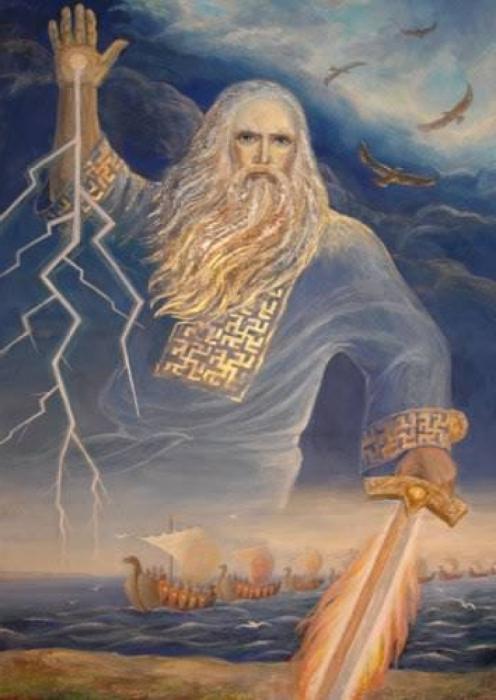 The Supreme was also revered by the god of fertility. This is the supreme deity, the son of Svarog, he was the patron saint of all living things: only he was able to send life-giving drops of rain, giving the long-awaited moisture to the withered earth. It was Perun who could punish people with drought and crop failure. Therefore, the Slavs firmly believed that only this god of fertility, lightning and rain can give them wealth. People also believed that Perun was capable of his golden lightning to expel evil demons attacking a man, and protect him from the magic spell.
The Supreme was also revered by the god of fertility. This is the supreme deity, the son of Svarog, he was the patron saint of all living things: only he was able to send life-giving drops of rain, giving the long-awaited moisture to the withered earth. It was Perun who could punish people with drought and crop failure. Therefore, the Slavs firmly believed that only this god of fertility, lightning and rain can give them wealth. People also believed that Perun was capable of his golden lightning to expel evil demons attacking a man, and protect him from the magic spell.
His wife was called Hathor. After Seth killed Osiris, seizing his throne, Horus fought with him for supremacy, finally succeeding in winning and inheriting his father's throne. Papyrus Hunefer says that Horus was given not only the throne of Egypt, but sovereignty over the whole world. As we have already seen, Osiris was Enki in the Sumerians and Seth, Enlile.
In addition to the heavenly divine function, Horus was also a god of war, like Marduk. Despite the fact that the myth describing the direct struggle between Marduk and Enlil, like that of the Egyptians, has not been preserved in Mesopotamia, we can assume that the latter did not leave the throne by peaceful means. Prior to the worship of Osiris, Seth’s older brother was called Heru-Ur. Some translated the name “Hero” through the “hawk”, influenced by its presentation, others, such as Horus. Therefore, Heru-Ur will mean "Horus the Elder" or "Old Savior."
Almost on the same level with Perun or the god Velez, Mokoshi’s husband, stood a step below him. He was considered the patron and guardian of hunters, herders, and later riches. Veles identified with the lower world - Navu. Regarded as the patron saint of the dead world, Veles was venerated by ancestors and as a god of fertility. It was believed that the souls of the departed may ask Veles for a good harvest, so in those days they always left a ribbon of uncleared cereals on the field - a gift to God with the aim of appeasing him. No wonder many images where Mokosh stretches her arms to the ground are interpreted as her request to her husband for a good harvest. This god was revered not only by the Slavs: Lithuanians even once celebrated the day of the memory of the departed, which was called “Veles time”. He is still revered in India, calling him Shiva.
On the Stone Shabak it is written that two brothers, Horus and Seth, fought for the domination of Egypt. Their father, Geb, gave Seth to Egypt, and Lower, to Horus, the frontier was “the border of two countries,” that is, the top of the Nile delta in Memphis. Later, Geb changed his mind and surrendered to Horus all over Egypt, this decision was approved by two rivals. In the Book of the Dead, Horus is called "Big Son" and "Born of Ra". Ra was the Egyptian equivalent of the Sumerian year, and An's firstborn, “the big son,” was Enki. The god of the storm for the Egyptians, Seth, is the god of the storm in Sumerians, Enlil.
Both Seth and Enlil fought with their elder brothers for supremacy. Horus Old and Osiris together with Enki and Nanna represent the same deity. In many inscriptions, Pharaoh, who identifies himself with Horus, is called "the son of Hathor." This epithet confused Egyptologists because Pharaoh, like Horus, is the son of Isis. But in the original myth, Hathor was the mother of Horus. She gave her the place of Isis with the appearance of the cult of Osiris, who had to be content with the role of the wife of Horus.
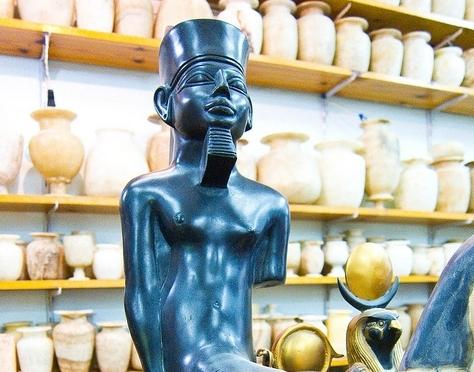
Such a cradle of civilization, like Egypt, also has its god of fertility. After all, it was not without reason that the Egyptians were considered to be among the best farmers in the world, adapting even the most barren soils to plantations. A huge role in obtaining a harvest for the people of this country is played by the Nile. But the main fertility god in Egypt is Min. He was also considered the patron saint of male power, depicting with an unnaturally large reproductive organ.
 magicov.ru Secrets of magic.
magicov.ru Secrets of magic.
